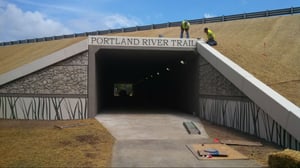Michigan’s Largest Lighted Pedestrian Tunnel Earns National Honors
(MDOT.com) –
Contact: John Richard, MDOT Office of Communications,
richardj2@michigan.gov
616-451-4063
Agency: Transportation
Fast Facts:
– The Portland Trail Pedestrian Tunnel project is this year’s winner of the American Concrete Pipe Association’s Annual Project Achievement Award.
– A precast concrete box culvert was used to replace two I-96 bridges over the Portland Trail in the city of Portland.
– Each of the forty-five sections weighed approximately 80,000 pounds, totaling 272 feet.
 November 20, 2013 — The Michigan Department of Transportation (MDOT) project to replace two I-96 bridges over the Portland Pedestrian Trail is this year’s winner of the American Concrete Pipe Association’s (ACPA) Annual Project Achievement Award. The award was presented in front of an audience of DOTs throughout the country at the American Association of State Highway and Transportation Officials (AASHTO) Bridge and Structures Committee meeting on June 17, in Portland, Ore. A separate, local award ceremony was held today in Grand Rapids.
November 20, 2013 — The Michigan Department of Transportation (MDOT) project to replace two I-96 bridges over the Portland Pedestrian Trail is this year’s winner of the American Concrete Pipe Association’s (ACPA) Annual Project Achievement Award. The award was presented in front of an audience of DOTs throughout the country at the American Association of State Highway and Transportation Officials (AASHTO) Bridge and Structures Committee meeting on June 17, in Portland, Ore. A separate, local award ceremony was held today in Grand Rapids.
To reduce maintenance and repair costs, forty-five lighted, precast box culverts were used to replace two aging I-96 bridges over the Portland Trail. The trail is an 8-mile loop that passes through wooded areas and open public spaces along the scenic Looking Glass and Grand rivers.
When MDOT first announced its intention to replace the bridges, the City of Portland’s Parks and Recreation Department, the local Rails to Trails chapter, and the general public voiced their concerns regarding the impact any work would have on the trail and its users.
“This project is a great example of what can be accomplished when governmental units work collaboratively,” said Tom Dempsey, Portland City Manager. “The box culvert’s appearance exceeded our expectations; it looks fantastic and adds to the experience of those using the trails in the City of Portland.”
MDOT weighed several construction alternatives and their impacts, while taking into account the need to maintain mobility for four lanes of interstate traffic that carry over 30,000 vehicles per day. MDOT’s analysis revealed that repairing the two bridges would actually cost more than removing the structures and replacing them with a large-capacity, precast concrete box culvert.
“It’s much more cost-effective using the culverts as opposed to repairing the two bridges,” said Greg Johnson, MDOT chief operations officer. “It’s not just the one-time savings. These culverts virtually eliminate future maintenance associated with bridges, and that’s great for mobility as well.”
As another benefit, assembly of the precast sections was accomplished prior to the demolition of the bridges, dramatically reducing the impact on I-96 traffic. Revised scheduling allowed crews to close the Portland Trail during the winter and early spring, when use of the trail is typically low.
MDOT says: Drive like you want to make it home tonight.

